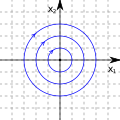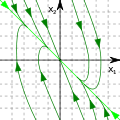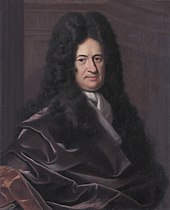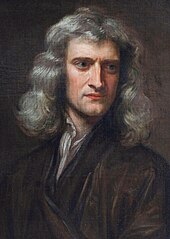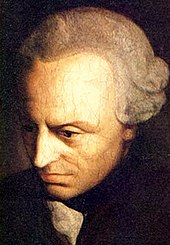Jules Henri Poincaré was a French mathematician, theoretical physicist, engineer, and philosopher of science. He is often described as a polymath, and in mathematics as "The Last Universalist," since he excelled in all fields of the discipline as it existed during his lifetime.
As a mathematician and physicist, he made many original fundamental contributions to pure and applied mathematics, mathematical physics, and celestial mechanics. He was responsible for formulating the Poincaré conjecture, which was one of the most famous unsolved problems in mathematics until it was solved in 2002–2003 by Grigori Perelman. In his research on the three-body problem, Poincaré became the first person to discover a chaotic deterministic system which laid the foundations of modern chaos theory. He is also considered to be one of the founders of the field of topology.
Poincaré made clear the importance of paying attention to the invariance of laws of physics under different transformations, and was the first to present the Lorentz transformations in their modern symmetrical form. Poincaré discovered the remaining relativistic velocity transformations and recorded them in a letter to Hendrik Lorentz in 1905. Thus he obtained perfect invariance of all of Maxwell's equations, an important step in the formulation of the theory of special relativity. In 1905, Poincaré first proposed gravitational waves (ondes gravifiques) emanating from a body and propagating at the speed of light as being required by the Lorentz transformations.
The Poincaré group used in physics and mathematics was named after him.
Life
Poincaré was born on 29 April 1854 in Cité Ducale neighborhood, Nancy, Meurthe-et-Moselle into an influential family. His father Leon Poincaré (1828–1892) was a professor of medicine at the University of Nancy. His younger sister Aline married the spiritual philosopher Emile Boutroux. Another notable member of Henri's family was his cousin, Raymond Poincaré, a fellow member of the Académie française, who would serve as President of France from 1913 to 1920. He was raised in the Roman Catholic faith.
Education
Plaque on the birthplace of Henri Poincaré at house number 117 on the Grande Rue in the city of Nancy.
During his childhood he was seriously ill for a time with diphtheria and received special instruction from his mother, Eugénie Launois (1830–1897).
In 1862, Henri entered the Lycée in Nancy (now renamed the Lycée Henri-Poincaréin his honour, along with Henri Poincaré University,
also in Nancy). He spent eleven years at the Lycée and during this time
he proved to be one of the top students in every topic he studied. He
excelled in written composition. His mathematics teacher described him
as a "monster of mathematics" and he won first prizes in the concours général,
a competition between the top pupils from all the Lycées across France.
His poorest subjects were music and physical education, where he was
described as "average at best". However, poor eyesight and a tendency towards absentmindedness may explain these difficulties. He graduated from the Lycée in 1871 with a bachelor's degree in letters and sciences.
During the Franco-Prussian War of 1870, he served alongside his father in the Ambulance Corps.
Poincaré entered the École Polytechnique in 1873 and graduated in 1875. There he studied mathematics as a student of Charles Hermite, continuing to excel and publishing his first paper (Démonstration nouvelle des propriétés de l'indicatrice d'une surface) in 1874. From November 1875 to June 1878 he studied at the École des Mines,
while continuing the study of mathematics in addition to the mining
engineering syllabus, and received the degree of ordinary mining
engineer in March 1879.
As a graduate of the École des Mines, he joined the Corps des Mines as an inspector for the Vesoul region in northeast France. He was on the scene of a mining disaster at Magny
in August 1879 in which 18 miners died. He carried out the official
investigation into the accident in a characteristically thorough and
humane way.
At the same time, Poincaré was preparing for his Doctorate in Science in mathematics under the supervision of Charles Hermite. His doctoral thesis was in the field of differential equations. It was named Sur les propriétés des fonctions définies par les équations aux différences partielles.
Poincaré devised a new way of studying the properties of these
equations. He not only faced the question of determining the integral of
such equations, but also was the first person to study their general
geometric properties. He realised that they could be used to model the
behaviour of multiple bodies in free motion within the solar system. Poincaré graduated from the University of Paris in 1879.
The young Henri Poincaré
First scientific achievements
After receiving his degree, Poincaré began teaching as junior lecturer in mathematics at the University of Caen in Normandy (in December 1879). At the same time he published his first major article concerning the treatment of a class of automorphic functions.
There, in Caen, he met his future wife, Louise Poulin d'Andesi
(Louise Poulain d'Andecy) and on 20 April 1881, they married. Together
they had four children: Jeanne (born 1887), Yvonne (born 1889),
Henriette (born 1891), and Léon (born 1893).
Poincaré immediately established himself among the greatest
mathematicians of Europe, attracting the attention of many prominent
mathematicians. In 1881 Poincaré was invited to take a teaching position
at the Faculty of Sciences of the University of Paris; he accepted the invitation. During the years of 1883 to 1897, he taught mathematical analysis in École Polytechnique.
In 1881–1882, Poincaré created a new branch of mathematics: qualitative theory of differential equations.
He showed how it is possible to derive the most important information
about the behavior of a family of solutions without having to solve the
equation (since this may not always be possible). He successfully used
this approach to problems in celestial mechanics and mathematical physics.
Career
He never
fully abandoned his mining career to mathematics. He worked at the
Ministry of Public Services as an engineer in charge of northern railway
development from 1881 to 1885. He eventually became chief engineer of
the Corps de Mines in 1893 and inspector general in 1910.
Beginning in 1881 and for the rest of his career, he taught at the University of Paris (the Sorbonne). He was initially appointed as the maître de conférences d'analyse (associate professor of analysis). Eventually, he held the chairs of Physical and Experimental Mechanics, Mathematical Physics and Theory of Probability, and Celestial Mechanics and Astronomy.
In 1887, at the young age of 32, Poincaré was elected to the French Academy of Sciences. He became its president in 1906, and was elected to the Académie française on 5 March 1908.
In 1887, he won Oscar II, King of Sweden's mathematical competition for a resolution of the three-body problem concerning the free motion of multiple orbiting bodies.
The Poincaré family grave at the Cimetière du Montparnasse
In 1893, Poincaré joined the French Bureau des Longitudes, which engaged him in the synchronisation of time around the world. In 1897 Poincaré backed an unsuccessful proposal for the decimalisation of circular measure, and hence time and longitude.
It was this post which led him to consider the question of establishing
international time zones and the synchronisation of time between bodies
in relative motion.
In 1899, and again more successfully in 1904, he intervened in the trials of Alfred Dreyfus.
He attacked the spurious scientific claims of some of the evidence
brought against Dreyfus, who was a Jewish officer in the French army
charged with treason by colleagues.
Poincaré was the President of the Société Astronomique de France (SAF), the French astronomical society, from 1901 to 1903.
Students
Poincaré had two notable doctoral students at the University of Paris, Louis Bachelier (1900) and Dimitrie Pompeiu (1905).
Death
In 1912, Poincaré underwent surgery for a prostate problem and subsequently died from an embolism on 17 July 1912, in Paris. He was 58 years of age. He is buried in the Poincaré family vault in the Cemetery of Montparnasse, Paris.
A former French Minister of Education, Claude Allègre, proposed in 2004 that Poincaré be reburied in the Panthéon in Paris, which is reserved for French citizens only of the highest honour.
Work
Summary
Poincaré made many contributions to different fields of pure and applied mathematics such as: celestial mechanics, fluid mechanics, optics, electricity, telegraphy, capillarity, elasticity, thermodynamics, potential theory, quantum theory, theory of relativity and physical cosmology.
He was also a populariser of mathematics and physics and wrote several books for the lay public.
Among the specific topics he contributed to are the following:
- algebraic topology
- the theory of analytic functions of several complex variables
- the theory of abelian functions
- algebraic geometry
- Poincaré was responsible for formulating one of the most famous problems in mathematics, the Poincaré conjecture, proven in 2003 by Grigori Perelman.
- Poincaré recurrence theorem
- hyperbolic geometry
- number theory
- the three-body problem
- the theory of diophantine equations
- the theory of electromagnetism
- the special theory of relativity
- In an 1894 paper, he introduced the concept of the fundamental group.
- In the field of differential equations Poincaré has given many results that are critical for the qualitative theory of differential equations, for example the Poincaré sphere and the Poincaré map.
- Poincaré on "everybody's belief" in the Normal Law of Errors
- Published an influential paper providing a novel mathematical argument in support of quantum mechanics.
Three-body problem
The
problem of finding the general solution to the motion of more than two
orbiting bodies in the solar system had eluded mathematicians since Newton's time. This was known originally as the three-body problem and later the n-body problem, where n is any number of more than two orbiting bodies. The n-body
solution was considered very important and challenging at the close of
the 19th century. Indeed, in 1887, in honour of his 60th birthday, Oscar II, King of Sweden, advised by Gösta Mittag-Leffler, established a prize for anyone who could find the solution to the problem. The announcement was quite specific:
Given a system of arbitrarily many mass points that attract each according to Newton's law, under the assumption that no two points ever collide, try to find a representation of the coordinates of each point as a series in a variable that is some known function of time and for all of whose values the series converges uniformly.
In case the problem could not be solved, any other important
contribution to classical mechanics would then be considered to be
prizeworthy. The prize was finally awarded to Poincaré, even though he
did not solve the original problem. One of the judges, the distinguished
Karl Weierstrass, said, "This
work cannot indeed be considered as furnishing the complete solution of
the question proposed, but that it is nevertheless of such importance
that its publication will inaugurate a new era in the history of
celestial mechanics." (The first version of his contribution even contained a serious error; for details see the article by Diacu and the book by Barrow-Green). The version finally printed contained many important ideas which led to the theory of chaos. The problem as stated originally was finally solved by Karl F. Sundman for n = 3 in 1912 and was generalised to the case of n > 3 bodies by Qiudong Wang in the 1990s.
Work on relativity
Marie Curie and Poincaré talk at the 1911 Solvay Conference
Local time
Poincaré's
work at the Bureau des Longitudes on establishing international time
zones led him to consider how clocks at rest on the Earth, which would
be moving at different speeds relative to absolute space (or the "luminiferous aether"), could be synchronised. At the same time Dutch theorist Hendrik Lorentz
was developing Maxwell's theory into a theory of the motion of charged
particles ("electrons" or "ions"), and their interaction with radiation.
In 1895 Lorentz had introduced an auxiliary quantity (without physical
interpretation) called "local time"
and introduced the hypothesis of length contraction to explain the failure of optical and electrical experiments to detect motion relative to the aether.
Poincaré was a constant interpreter (and sometimes friendly critic) of
Lorentz's theory. Poincaré as a philosopher was interested in the
"deeper meaning". Thus he interpreted Lorentz's theory and in so doing
he came up with many insights that are now associated with special
relativity. In The Measure of Time
(1898), Poincaré said, "
A little reflection is sufficient to understand that all these
affirmations have by themselves no meaning. They can have one only as
the result of a convention." He also argued that scientists have to set
the constancy of the speed of light as a postulate to give physical theories the simplest form.
Based on these assumptions he discussed in 1900 Lorentz's "wonderful
invention" of local time and remarked that it arose when moving clocks
are synchronised by exchanging light signals assumed to travel with the
same speed in both directions in a moving frame.
Principle of relativity and Lorentz transformations
In 1881 Poincaré described hyperbolic geometry in terms of Weierstrass coordinates of the hyperboloid model. There, he formulated transformations leaving invariant the Lorentz interval , which makes them mathematically equivalent to the Lorentz transformations in 2+1 dimensions.
He discussed the "principle of relative motion" in two papers in 1900
and named it the principle of relativity in 1904, according to which no physical experiment can discriminate between a state of uniform motion and a state of rest.
In 1905 Poincaré wrote to Lorentz about Lorentz's paper of 1904, which
Poincaré described as a "paper of supreme importance." In this letter he
pointed out an error Lorentz had made when he had applied his
transformation to one of Maxwell's equations, that for charge-occupied
space, and also questioned the time dilation factor given by Lorentz.
In a second letter to Lorentz, Poincaré gave his own reason why
Lorentz's time dilation factor was indeed correct after all—it was
necessary to make the Lorentz transformation form a group—and he gave
what is now known as the relativistic velocity-addition law.
Poincaré later delivered a paper at the meeting of the Academy of
Sciences in Paris on 5 June 1905 in which these issues were addressed.
In the published version of that he wrote:
The essential point, established by Lorentz, is that the equations of the electromagnetic field are not altered by a certain transformation (which I will call by the name of Lorentz) of the form:
and showed that the arbitrary function must be unity for all (Lorentz had set
by a different argument) to make the transformations form a group. In
an enlarged version of the paper that appeared in 1906 Poincaré pointed
out that the combination is invariant. He noted that a Lorentz transformation is merely a rotation in four-dimensional space about the origin by introducing as a fourth imaginary coordinate, and he used an early form of four-vectors.
Poincaré expressed a lack of interest in a four-dimensional
reformulation of his new mechanics in 1907, because in his opinion the
translation of physics into the language of four-dimensional geometry
would entail too much effort for limited profit. So it was Hermann Minkowski who worked out the consequences of this notion in 1907.
Mass–energy relation
Like others before, Poincaré (1900) discovered a relation between mass and electromagnetic energy. While studying the conflict between the action/reaction principle and Lorentz ether theory, he tried to determine whether the center of gravity still moves with a uniform velocity when electromagnetic fields are included.
He noticed that the action/reaction principle does not hold for matter
alone, but that the electromagnetic field has its own momentum. Poincaré
concluded that the electromagnetic field energy of an electromagnetic
wave behaves like a fictitious fluid (fluide fictif) with a mass density of E/c2. If the center of mass frame is defined by both the mass of matter and
the mass of the fictitious fluid, and if the fictitious fluid is
indestructible—it's neither created or destroyed—then the motion of the
center of mass frame remains uniform. But electromagnetic energy can be
converted into other forms of energy. So Poincaré assumed that there
exists a non-electric energy fluid at each point of space, into which
electromagnetic energy can be transformed and which also carries a mass
proportional to the energy. In this way, the motion of the center of
mass remains uniform. Poincaré said that one should not be too surprised
by these assumptions, since they are only mathematical fictions.
However, Poincaré's resolution led to a paradox when changing
frames: if a Hertzian oscillator radiates in a certain direction, it
will suffer a recoil from the inertia of the fictitious fluid. Poincaré performed a Lorentz boost (to order v/c)
to the frame of the moving source. He noted that energy conservation
holds in both frames, but that the law of conservation of momentum is
violated. This would allow perpetual motion,
a notion which he abhorred. The laws of nature would have to be
different in the frames of reference, and the relativity principle would
not hold. Therefore, he argued that also in this case there has to be
another compensating mechanism in the ether.
Poincaré himself came back to this topic in his St. Louis lecture (1904). This time (and later also in 1908) he rejected the possibility that energy carries mass and criticized the ether solution to compensate the above-mentioned problems:
The apparatus will recoil as if it were a cannon and the projected energy a ball, and that contradicts the principle of Newton, since our present projectile has no mass; it is not matter, it is energy. [..] Shall we say that the space which separates the oscillator from the receiver and which the disturbance must traverse in passing from one to the other, is not empty, but is filled not only with ether, but with air, or even in inter-planetary space with some subtile, yet ponderable fluid; that this matter receives the shock, as does the receiver, at the moment the energy reaches it, and recoils, when the disturbance leaves it? That would save Newton's principle, but it is not true. If the energy during its propagation remained always attached to some material substratum, this matter would carry the light along with it and Fizeau has shown, at least for the air, that there is nothing of the kind. Michelson and Morley have since confirmed this. We might also suppose that the motions of matter proper were exactly compensated by those of the ether; but that would lead us to the same considerations as those made a moment ago. The principle, if thus interpreted, could explain anything, since whatever the visible motions we could imagine hypothetical motions to compensate them. But if it can explain anything, it will allow us to foretell nothing; it will not allow us to choose between the various possible hypotheses, since it explains everything in advance. It therefore becomes useless.
He also discussed two other unexplained effects: (1) non-conservation of mass implied by Lorentz's variable mass , Abraham's theory of variable mass and Kaufmann's experiments on the mass of fast moving electrons and (2) the non-conservation of energy in the radium experiments of Madame Curie.
It was Albert Einstein's concept of mass–energy equivalence (1905) that a body losing energy as radiation or heat was losing mass of amount m = E/c2 that resolved Poincaré's paradox, without using any compensating mechanism within the ether.
The Hertzian oscillator loses mass in the emission process, and
momentum is conserved in any frame. However, concerning Poincaré's
solution of the Center of Gravity problem, Einstein noted that
Poincaré's formulation and his own from 1906 were mathematically
equivalent.
Gravitational waves
In 1905 Henri Poincaré first proposed gravitational waves (ondes gravifiques) emanating from a body and propagating at the speed of light. "Il
importait d'examiner cette hypothèse de plus près et en particulier de
rechercher quelles modifications elle nous obligerait à apporter aux
lois de la gravitation. C'est ce que j'ai cherché à déterminer; j'ai été
d'abord conduit à supposer que la propagation de la gravitation n'est
pas instantanée, mais se fait avec la vitesse de la lumière."
Poincaré and Einstein
Einstein's first paper on relativity was published three months after Poincaré's short paper, but before Poincaré's longer version.
Einstein relied on the principle of relativity to derive the Lorentz
transformations and used a similar clock synchronisation procedure
to the one that Poincaré (1900) had described, but Einstein's paper was
remarkable in that it contained no references at all. Poincaré never
acknowledged Einstein's work on special relativity. However, Einstein expressed sympathy with Poincaré's outlook obliquely in a letter to Hans Vaihinger
on 3 May 1919, when Einstein considered Vaihinger's general outlook to
be close to his own and Poincaré's to be close to Vaihinger's. In public, Einstein acknowledged Poincaré posthumously in the text of a lecture in 1921 called Geometrie und Erfahrung in connection with non-Euclidean geometry,
but not in connection with special relativity. A few years before his
death, Einstein commented on Poincaré as being one of the pioneers of
relativity, saying "Lorentz had already recognised that the
transformation named after him is essential for the analysis of
Maxwell's equations, and Poincaré deepened this insight still further
...."
Assessments on Poincaré and relativity
Poincaré's work in the development of special relativity is well recognised,
though most historians stress that despite many similarities with
Einstein's work, the two had very different research agendas and
interpretations of the work.
Poincaré developed a similar physical interpretation of local time and
noticed the connection to signal velocity, but contrary to Einstein he
continued to use the ether-concept in his papers and argued that clocks
at rest in the ether show the "true" time, and moving clocks show the
local time. So Poincaré tried to keep the relativity principle in
accordance with classical concepts, while Einstein developed a
mathematically equivalent kinematics based on the new physical concepts
of the relativity of space and time.
While this is the view of most historians, a minority go much further, such as E. T. Whittaker, who held that Poincaré and Lorentz were the true discoverers of relativity.
Algebra and number theory
Poincaré introduced group theory to physics, and was the first to study the group of Lorentz transformations. He also made major contributions to the theory of discrete groups and their representations.
Topology
The subject is clearly defined by Felix Klein
in his "Erlangen Program" (1872): the geometry invariants of arbitrary
continuous transformation, a kind of geometry. The term "topology" was
introduced, as suggested by Johann Benedict Listing, instead of previously used "Analysis situs". Some important concepts were introduced by Enrico Betti and Bernhard Riemann.
But the foundation of this science, for a space of any dimension, was
created by Poincaré. His first article on this topic appeared in 1894.
His research in geometry led to the abstract topological definition of homotopy and homology. He also first introduced the basic concepts and invariants of combinatorial topology, such as Betti numbers and the fundamental group. Poincaré proved a formula relating the number of edges, vertices and faces of n-dimensional
polyhedron (the Euler–Poincaré theorem) and gave the first precise
formulation of the intuitive notion of dimension.
Astronomy and celestial mechanics
Poincaré published two now classical monographs, "New Methods of
Celestial Mechanics" (1892–1899) and "Lectures on Celestial Mechanics"
(1905–1910). In them, he successfully applied the results of their
research to the problem of the motion of three bodies and studied in
detail the behavior of solutions (frequency, stability, asymptotic, and
so on). They introduced the small parameter method, fixed points,
integral invariants, variational equations, the convergence of the
asymptotic expansions. Generalizing a theory of Bruns (1887), Poincaré
showed that the three-body problem is not integrable. In other words,
the general solution of the three-body problem can not be expressed in
terms of algebraic and transcendental functions through unambiguous
coordinates and velocities of the bodies. His work in this area was the
first major achievement in celestial mechanics since Isaac Newton.
These monographs include an idea of Poincaré, which later became the base for mathematical "chaos theory" (see, in particular, the Poincaré recurrence theorem) and the general theory of dynamical systems.
Poincaré authored important works on astronomy for the equilibrium
figures of a gravitating rotating fluid. He introduced the important
concept of bifurcation points and proved the existence of equilibrium
figures such as the non-ellipsoids, including ring-shaped and
pear-shaped figures, and their stability. For this discovery, Poincaré
received the Gold Medal of the Royal Astronomical Society (1900).
Differential equations and mathematical physics
After
defending his doctoral thesis on the study of singular points of the
system of differential equations, Poincaré wrote a series of memoirs
under the title "On curves defined by differential equations"
(1881–1882). In these articles, he built a new branch of mathematics, called "qualitative theory of differential equations".
Poincaré showed that even if the differential equation can not be
solved in terms of known functions, yet from the very form of the
equation, a wealth of information about the properties and behavior of
the solutions can be found. In particular, Poincaré investigated the
nature of the trajectories of the integral curves in the plane, gave a
classification of singular points (saddle, focus, center, node),
introduced the concept of a limit cycle and the loop index, and showed
that the number of limit cycles is always finite, except for some
special cases. Poincaré also developed a general theory of integral
invariants and solutions of the variational equations. For the
finite-difference equations, he created a new direction – the asymptotic
analysis of the solutions. He applied all these achievements to study
practical problems of mathematical physics and celestial mechanics, and the methods used were the basis of its topological works.
- The singular points of the integral curves
Character
Photographic portrait of H. Poincaré by Henri Manuel
Poincaré's work habits have been compared to a bee flying from flower
to flower. Poincaré was interested in the way his mind worked; he
studied his habits and gave a talk about his observations in 1908 at the
Institute of General Psychology in Paris. He linked his way of thinking
to how he made several discoveries.
The mathematician Darboux claimed he was un intuitif
(intuitive), arguing that this is demonstrated by the fact that he
worked so often by visual representation. He did not care about being
rigorous and disliked logic. (Despite this opinion, Jacques Hadamard wrote that Poincaré's research demonstrated marvelous clarity
and Poincaré himself wrote that he believed that logic was not a way
to invent but a way to structure ideas and that logic limits ideas.)
Toulouse's characterisation
Poincaré's
mental organisation was not only interesting to Poincaré himself but
also to Édouard Toulouse, a psychologist of the Psychology Laboratory of
the School of Higher Studies in Paris. Toulouse wrote a book entitled Henri Poincaré (1910). In it, he discussed Poincaré's regular schedule:
- He worked during the same times each day in short periods of time. He undertook mathematical research for four hours a day, between 10 a.m. and noon then again from 5 p.m. to 7 p.m.. He would read articles in journals later in the evening.
- His normal work habit was to solve a problem completely in his head, then commit the completed problem to paper.
- He was ambidextrous and nearsighted.
- His ability to visualise what he heard proved particularly useful when he attended lectures, since his eyesight was so poor that he could not see properly what the lecturer wrote on the blackboard.
These abilities were offset to some extent by his shortcomings:
- He was physically clumsy and artistically inept.
- He was always in a rush and disliked going back for changes or corrections.
- He never spent a long time on a problem since he believed that the subconscious would continue working on the problem while he consciously worked on another problem.
In addition, Toulouse stated that most mathematicians worked from
principles already established while Poincaré started from basic
principles each time (O'Connor et al., 2002).
His method of thinking is well summarised as:
Habitué à négliger les détails et à ne regarder que les cimes, il passait de l'une à l'autre avec une promptitude surprenante et les faits qu'il découvrait se groupant d'eux-mêmes autour de leur centre étaient instantanément et automatiquement classés dans sa mémoire. (Accustomed to neglecting details and to looking only at mountain tops, he went from one peak to another with surprising rapidity, and the facts he discovered, clustering around their center, were instantly and automatically pigeonholed in his memory.)
— Belliver (1956)
Attitude towards transfinite numbers
Poincaré was dismayed by Georg Cantor's theory of transfinite numbers, and referred to it as a "disease" from which mathematics would eventually be cured.
Poincaré said, "There is no actual infinite; the Cantorians have
forgotten this, and that is why they have fallen into contradiction."
Honours
Awards
- Oscar II, King of Sweden's mathematical competition (1887)
- Foreign member of the Royal Netherlands Academy of Arts and Sciences (1897)[65]
- American Philosophical Society 1899
- Gold Medal of the Royal Astronomical Society of London (1900)
- Bolyai Prize in 1905
- Matteucci Medal 1905
- French Academy of Sciences 1906
- Académie française 1909
- Bruce Medal 1911
Named after him
- Institut Henri Poincaré (mathematics and theoretical physics center)
- Poincaré Prize (Mathematical Physics International Prize)
- Annales Henri Poincaré (Scientific Journal)
- Poincaré Seminar (nicknamed "Bourbaphy")
- The crater Poincaré on the Moon
- Asteroid 2021 Poincaré
- List of things named after Henri Poincaré
Henri Poincaré did not receive the Nobel Prize in Physics, but he had influential advocates like Henri Becquerel or committee member Gösta Mittag-Leffler. The nomination archive reveals that Poincaré received a total of 51 nominations between 1904 and 1912, the year of his death. Of the 58 nominations for the 1910 Nobel Prize, 34 named Poincaré. Nominators included Nobel laureates Hendrik Lorentz and Pieter Zeeman (both of 1902), Marie Curie (of 1903), Albert Michelson (of 1907), Gabriel Lippmann (of 1908) and Guglielmo Marconi (of 1909).
The fact that renowned theoretical physicists like Poincaré,
Boltzmann or Gibbs were not awarded the Nobel Prize is seen as evidence
that the Nobel committee had more regard for experimentation than
theory.
In Poincaré's case, several of those who nominated him pointed out that
the greatest problem was to name a specific discovery, invention, or
technique.
Philosophy
Poincaré had philosophical views opposite to those of Bertrand Russell and Gottlob Frege, who believed that mathematics was a branch of logic. Poincaré strongly disagreed, claiming that intuition was the life of mathematics. Poincaré gives an interesting point of view in his book Science and Hypothesis:
For a superficial observer, scientific truth is beyond the possibility of doubt; the logic of science is infallible, and if the scientists are sometimes mistaken, this is only from their mistaking its rule.
Poincaré believed that arithmetic is a synthetic science. He argued that Peano's axioms cannot be proven non-circularly with the principle of induction (Murzi, 1998), therefore concluding that arithmetic is a priori
synthetic and not analytic. Poincaré then went on to say that
mathematics cannot be deduced from logic since it is not analytic. His
views were similar to those of Immanuel Kant (Kolak, 2001, Folina 1992). He strongly opposed Cantorian set theory, objecting to its use of impredicative definitions.
However, Poincaré did not share Kantian views in all branches of
philosophy and mathematics. For example, in geometry, Poincaré believed
that the structure of non-Euclidean space
can be known analytically. Poincaré held that convention plays an
important role in physics. His view (and some later, more extreme
versions of it) came to be known as "conventionalism". Poincaré believed that Newton's first law was not empirical but is a conventional framework assumption for mechanics (Gargani, 2012).
He also believed that the geometry of physical space is conventional.
He considered examples in which either the geometry of the physical
fields or gradients of temperature can be changed, either describing a
space as non-Euclidean measured by rigid rulers, or as a Euclidean space
where the rulers are expanded or shrunk by a variable heat
distribution. However, Poincaré thought that we were so accustomed to Euclidean geometry
that we would prefer to change the physical laws to save Euclidean
geometry rather than shift to a non-Euclidean physical geometry.
Free will
Poincaré's famous lectures before the Société de Psychologie in Paris (published as Science and Hypothesis, The Value of Science, and Science and Method) were cited by Jacques Hadamard
as the source for the idea that creativity and invention consist of two
mental stages, first random combinations of possible solutions to a
problem, followed by a critical evaluation.
Although he most often spoke of a deterministic universe,
Poincaré said that the subconscious generation of new possibilities
involves chance.
It is certain that the combinations which present themselves to the mind in a kind of sudden illumination after a somewhat prolonged period of unconscious work are generally useful and fruitful combinations... all the combinations are formed as a result of the automatic action of the subliminal ego, but those only which are interesting find their way into the field of consciousness... A few only are harmonious, and consequently at once useful and beautiful, and they will be capable of affecting the geometrician's special sensibility I have been speaking of; which, once aroused, will direct our attention upon them, and will thus give them the opportunity of becoming conscious... In the subliminal ego, on the contrary, there reigns what I would call liberty, if one could give this name to the mere absence of discipline and to disorder born of chance.
Poincaré's two stages—random combinations followed by selection—became the basis for Daniel Dennett's two-stage model of free will.


















